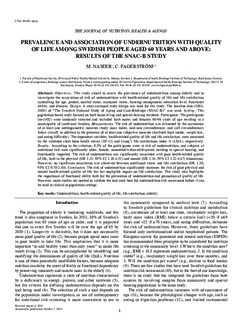| dc.identifier.citation | Naseer, M., & Fagerström, C. (2015). Prevalence and association of undernutrition with quality of life among Swedish people aged 60 years and above: Results of the SNAC-B study. The journal of nutrition, health & aging, 19(10), 970-979. | nb_NO |
| dc.description.abstract | Objectives: This study aimed to assess the prevalence of undernutrition among elderly and to investigate the association of risk of undernutrition with health-related quality of life and life satisfaction controlling for age, gender, marital status, economic status, housing arrangement, education level, functional ability, and diseases.
Design: A cross-sectional study design was used for this study. The baseline data (2001-2003) of "The Swedish National Study of Aging and Care-Blekinge (SNAC-B)" was used. Setting This population-based study focused on both home-living and special-housing residents. Participants: The participants (n=1402) were randomly selected and included both males and females 60-96 years of age residing in a municipality of south-east Sweden.
Measurements: The risk of undernutrition was estimated by the occurrence of at least one anthropometric measure (body mass index, mid-arm circumference, and calf circumference) below cut-off, in addition to the presence of at least one subjective measure (declined food intake, weight loss, and eating difficulty). The dependent variables, health-related quality of life and life satisfaction, were measured by the validated short form health survey (SF-12) and Liang's life satisfactions index A (LSIA), respectively.
Results: According to the criterion, 8.5% of the participants were at risk of undernutrition, and subjects at nutritional risk were significantly older, female, unmarried/widowed/divorced, residing in special housing, and functionally impaired. The risk of undernutrition was significantly associated with poor health-related quality of life, both in the physical (OR 2.31, 95% CI 1.18--4.52) and mental (OR 2.34, 95% CI 1.22--4.47) dimensions. However, no significant association was observed between nutritional status and life satisfaction (OR 1.30, 95% CI 0.70--2.40).
Conclusion: The risk of undernutrition significantly increases the risk of poor physical and mental health-related quality of life but has negligible impact on life satisfaction. This study also highlights the importance of functional ability both for the prevention of undernutrition and promotion of quality of life. However, more studies are needed to validate the tool used here for undernutrition risk assessment before it can be used in clinical or population settings. | nb_NO |
